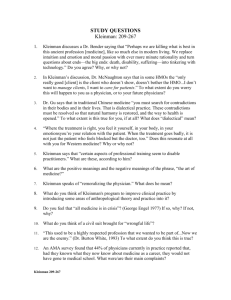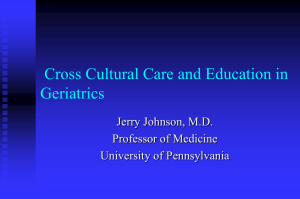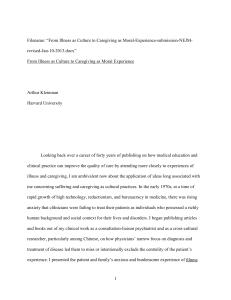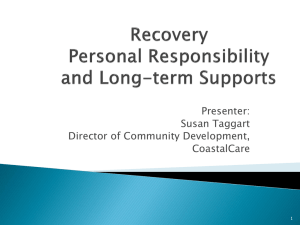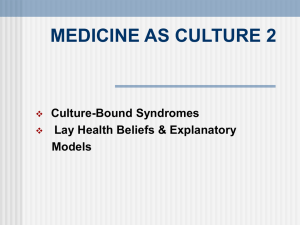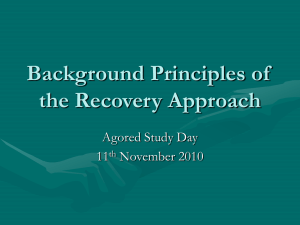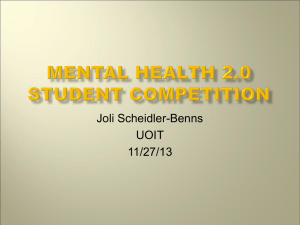The Explanatory Model
advertisement
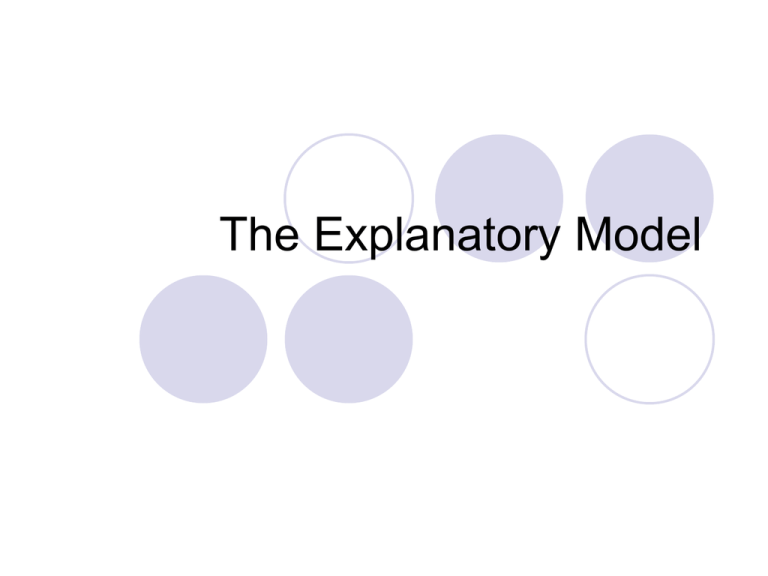
The Explanatory Model Theories of Patient/Doctor Interaction and Illness behavior Howard Waitzkin Arthur Kleinman Howard Leventhal Howard Waitzkin Structuralistic approach Medical system as an agent of control, focussing on two issues: 1. Medicine defines the ability to work and therefore supports the system of production. 2. Medicine supports the system of biological reproduction to produce workforce. Arthur Kleinman The Medical System Disease/Illness dichotomy The Explantory Model Arthur Kleinman The medical system The popular sector The folk sector The professional sector “The health care system itsself has a healing effect, not only the healer.“ Disease/Illness Dichotomy "Sickness" is what is happening to the patient. Listen to him. Disease is what is happening to science and to populations. (Weed 1978) Illness includes all the secondary personal and social responses to a primary malfunctioning (disease). (Kleinman 1980) Arthur Kleinman The Explantory Model “Explanatory Models are the notions about an Episode of sickness and its treatment that are employed by all those engaged in the clinical process.” (Kleinman 1980) Arthur Kleinman The Explanatory Model Explanatory Models contain the following elements: Etiology time and mode of onset of symptoms pathophysiology course of sickness treatment Arthur Kleinman The Explanatory Model The specific EM is constituted in a „semantic illness network“ Lay / Professional EM‘s Theoretical / clinical EM‘s Psychsomatic / Physical EM‘s domain-specifity hypotheses / crossdomain hypotheses Arthur Kleinman The Explanatory Model A study conducted among taiwanese parents about their EM’s concerning the etiologiy of the autism of their children found a coexistance of biomedical and supernatural causes, that where integrated in one model without apparent conflict (Shyu, Tsai and Tsai 2010). Howard Leventhal The common sense model of illness heuristic device to assist understanding individuals’ responses to the threat of an illness CSM focus is nearly entirely on the patients model Howard Leventhal The common sense model of illness Includes 5 components: (a) identity: a label of the illness and the symptoms associated with it; (b) cause: factors leading to the onset of the illness; (c) consequences: both long and short term effects; (d) time line: moment of onset, expected duration and periodicity (acute, cyclic, or chronic). (e) later added: cure or control (how one recovers) References Waitzkin, H. (1984) The micropolitics of medicine: a contextual analysis. Int J Health Serv, 14, 339-78 Kleinman, A. 1980. Patients and healers in the context of culture : an exploration of the borderland between anthropology, medicine, and psychiatry. Berkeley: University of California Press Diefenbach, M. & H. Leventhal (1996) The commonsense model of illness Shyu, Y. I., J. L. Tsai & W. C. Tsai (2010) Explaining and Selecting Treatments for Autism: Parental Explanatory Models in Taiwan. J Autism Dev Disord. Weed LL. Your health care and how to manage it . Rev . ed . EssexJunction, VT : Essex Publishing, 1978 Vielen Dank für die Aufmerksamkeit!
